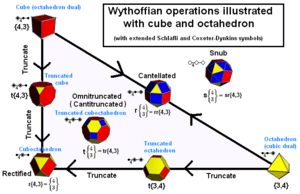Archimedean solid facts for kids

In geometry, an Archimedean solid is a special type of 3D shape called a polyhedron. Imagine a shape made of flat faces, straight edges, and sharp corners. Archimedean solids are unique because:
- Each face is a regular polygon (like a square, triangle, or pentagon where all sides and angles are equal).
- All the corners (called vertices) look exactly the same.
- They are not Platonic solids, prisms, or antiprisms.
There are usually considered to be 13 such shapes. Two of these shapes also have a "mirror image" version, meaning they can't be rotated to look exactly the same as their original. These cool shapes are named after the ancient Greek mathematician Archimedes, who probably found them around 250 BC. His original writings are lost, but other mathematicians later described them. During the Renaissance, artists and mathematicians rediscovered these forms. Johannes Kepler likely finished finding all of them around 1620.
To build an Archimedean solid, you need at least two different types of regular polygons for its faces. For example, a soccer ball (which is a truncated icosahedron) uses both pentagons and hexagons.
Contents
What Makes Them Special?
- Equal Edges: Since Archimedean solids are made from regular polygons, all their edges are the same length. This makes them very symmetrical.
- From Platonic Solids: You can often create Archimedean solids by "cutting" or "truncating" the corners or edges of Platonic solids. Platonic solids are even simpler 3D shapes, like a perfect cube or a pyramid with four triangle sides.
- Same Corners: Every corner of an Archimedean solid looks identical. If you stand at any corner and look around, you'll see the same pattern of polygons meeting there.
How They Relate to Platonic Solids
Archimedean solids are closely related to Platonic solids. Think of Platonic solids as the basic building blocks. By carefully cutting off their corners or edges in a specific way, you can transform them into Archimedean solids. This process is called truncation.
List of Archimedean Solids
Here is a list of the main Archimedean solids:
| Image | Name | Faces | Type of Faces | Edges | Vertices |
|---|---|---|---|---|---|
 |
Truncated tetrahedron | 8 | 4 triangles 4 hexagons |
18 | 12 |
 |
Cuboctahedron | 14 | 8 triangles 6 squares |
24 | 12 |
 |
Truncated cube | 14 | 8 triangles 6 octagons |
36 | 24 |
 |
Truncated octahedron | 14 | 6 squares 8 hexagons |
36 | 24 |
 |
Rhombicuboctahedron | 26 | 8 triangles 18 squares |
48 | 24 |
 |
Truncated cuboctahedron | 26 | 12 squares 8 hexagons 6 octagons |
72 | 48 |
  |
Snub cube (2 mirrored versions) | 38 | 32 triangles 6 squares |
60 | 24 |
 |
Icosidodecahedron | 32 | 20 triangles 12 pentagons |
60 | 30 |
 |
Truncated dodecahedron | 32 | 20 triangles 12 decagons |
90 | 60 |
 |
Truncated icosahedron | 32 | 12 pentagons 20 hexagons |
90 | 60 |
 |
Rhombicosidodecahedron | 62 | 20 triangles 30 squares 12 pentagons |
120 | 60 |
 |
Truncated icosidodecahedron | 62 | 30 squares 20 hexagons 12 decagons |
180 | 120 |
  |
Snub dodecahedron (2 mirrored versions) | 92 | 80 triangles 12 pentagons |
150 | 60 |
See also
 In Spanish: Sólidos arquimedianos para niños
In Spanish: Sólidos arquimedianos para niños


